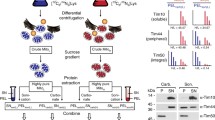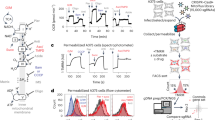Abstract
The control of intricate networks within eukaryotic cells relies on differential compartmentalization of proteins. We have developed a method that allows rapid identification of novel proteins compartmentalized in mitochondria by screening large-scale cDNA libraries. The principle is based on reconstitution of split-enhanced green fluorescent protein (EGFP) by protein splicing of DnaE derived from Synechocystis sp. PCC6803. The cDNA libraries are expressed in mammalian cells following infection with retrovirus. If a test protein contains a functional mitochondrial targeting signal (MTS), it translocates into the mitochondrial matrix, where EGFP is then formed by protein splicing. The cells harboring this reconstituted EGFP are screened rapidly by fluorescence-activated cell sorting, and the cDNAs are isolated and identified from the cells. The analysis of 258 cDNAs revealed various MTSs, among which we identified new transcripts corresponding to mitochondrial proteins. This method should provide a means to map proteins distributed within intracellular organelles in a broad range of different tissues and disease states.





Similar content being viewed by others
References
Lopez, M.F. & Melov, S. Applied proteomics. Mitochondrial proteins and effect on function. Circ. Res. 90, 380–389 (2002).
Bell, A.W. et al. Proteomics characterization of abundant Golgi membrane proteins. J. Biol. Chem. 276, 5152–5165 (2001).
Kruft, V., Eubel, E., Jansch, L., Werhahn, W. & Braun, H.P. Proteomic approach to identify novel mitochondrial proteins in Arabidopsis. Plant Physiol. 127, 1694–1710 (2001).
Maltman, D.J. et al. Proteomic analysis of the endoplasmic reticulum from developing and germinating seed of castor (Ricinus communis). Electrophoresis 23, 626–639 (2002).
Wijk, K. Proteomics of the chloroplast: experimentation and prediction. Trends Plant Sci. 5, 420–425 (2000).
Ueki, N. et al. Selection system for genes encoding nuclear-targeted proteins. Nat. Biotechnol. 16, 1338–1342 (1998).
Rhee, Y., Gurel, F., Gafni, Y., Dingwall, C. & Citovsky, V. A genetic system for detection of protein nuclear import and export. Nat. Biotechnol. 18, 433–437 (2000).
Bejarano, L.A. & González, C. Motif trap: a rapid method to clone motifs that can target proteins to defined subcellular localisations. J. Cell Sci. 112, 4207–4211 (1999).
Misawa, K. et al. A method to identify cDNAs based on localization of green fluorescent protein fusion products. Proc. Natl. Acad. Sci. USA 97, 3062–3066 (2000).
Simpson, J.C., Wellenreuther, R., Poustka, A., Pepperkok, R. & Wiemann, S. Systematic subcellular localization of novel proteins identified by large-scale cDNA sequencing. EMBO Report 1, 287–292 (2000).
Kumar, A. et al. Subcellular localization of the yeast proteome. Genes & Dev. 16, 707–719 (2002).
Ozawa, T. & Umezawa, Y. Peptide assemblies in living cells. Methods for detecting protein–protein interactions. Supramol. Chem. 14, 271–280 (2002).
Ozawa, T., Takeuchi, M., Kaihara, A., Sato, M. & Umezawa, Y. Protein splicing-based reconstitution of split green fluorescent protein for monitoring protein–protein interactions in bacteria: improved sensitivity and reduced screening time. Anal. Chem. 73, 5866–5874 (2001).
Ozawa, T. & Umezawa, Y. Detection of protein-protein interactions in vivo based on protein splicing. Curr. Opin. Chem. Biol. 5, 578–583 (2001).
Evans, T.C.J. et al. Protein trans-splicing and cyclization by a naturally split intein from the dnaE gene of Synechocystis species PCC6803. J. Biol. Chem. 275, 9091–9094 (2000).
Roise, D. et al. Amphiphilicity is essential for mitochondrial presequence function. EMBO J. 7, 649–653 (1988).
Heijne, G. Mitochondrial targeting sequences may form amphiphilic helices. EMBO J. 5, 1335–1342 (1986).
Morita, S., Kojima, T. & Kitamura, T. Plat-E: an efficient and stable system for transient packaging of retroviruses. Gene Therapy 7, 1063–1066 (2000).
Hayashizaki, Y. et al. Functional annotation of a full-length mouse cDNA collection. Nature 409, 685–690 (2001).
Carninci, P. et al. Normalization and subtraction of cap-trapper-selected cDNAs to prepare full-length cDNA libraries for rapid discovery of new genes. Genome Res. 10, 1617–1630 (2000).
Lee, C.M., Sedman, J., Neupert, W. & Stuart, R.A. The DNA helicase, Hmi1p, is transported into mitochondria by a C-terminal cleavable targeting signal. J. Biol. Chem. 274, 20937–20942 (1999).
Acknowledgements
This work has been supported by Core Research for Evolutional Science and Technology of Japan Science and Technology and by grants to Y.U. from the Ministry of Education, Science and Culture, Japan.
Author information
Authors and Affiliations
Corresponding author
Ethics declarations
Competing interests
The authors declare no competing financial interests.
Supplementary information
Rights and permissions
About this article
Cite this article
Ozawa, T., Sako, Y., Sato, M. et al. A genetic approach to identifying mitochondrial proteins. Nat Biotechnol 21, 287–293 (2003). https://doi.org/10.1038/nbt791
Received:
Accepted:
Published:
Issue Date:
DOI: https://doi.org/10.1038/nbt791
- Springer Nature America, Inc.
This article is cited by
-
A genetic screen to discover SUMOylated proteins in living mammalian cells
Scientific Reports (2017)
-
Efficient generation of bispecific IgG antibodies by split intein mediated protein trans-splicing system
Scientific Reports (2017)
-
Split-inteins and their bioapplications
Biotechnology Letters (2015)
-
Recent advances in in vivo applications of intein-mediated protein splicing
Mobile DNA (2014)
-
Comparative mitochondrial proteomics: perspective in human diseases
Journal of Hematology & Oncology (2012)





